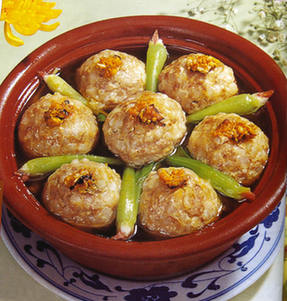|
Financing Cultural Undertakings
Scholarly honors and official rank counted for more than money in this region, so while the salt tycoons might have been rich, their social status was not high and they were seen as arrivistes. To counteract such feelings of social inferiority, they befriended scholars, endowed cultural undertakings and encouraged their offspring to take part in the imperial examinations so as to open the path into officialdom. Such efforts greatly promoted social morality and elevated the general society of Yangzhou. Seeking social acceptance, merchants pursued the Jiangnan ethos in fields such as poetry, painting, stage art and gastronomy. Objectively, this promoted Yangzhou's cultural development and prosperity.
The Yangzhou salt merchants' greatest cultural contribution was the founding and funding of academies of classical learning, such as the Meihua, Anding, Zizheng and Weiyang academies. The teachers were mostly famous scholars who brought high prestige and commanded handsome salaries. The ''Yangzhou School'' gradually came into being in this hothouse academic atmosphere. Scholars of this school advocated seeking truth from facts and emphasized practice, making an important contribution to the development of China's ''Practical Learning School.'' This had much to do with the financial muscle of Yangzhou's salt tycoons, who recruited scholars from around China. Sadly, warfare destroyed all but one of these academies – the Meihua Academy of Classical Learning. In 2010, the Yangzhou municipal government funded its renovation and it will reopen during the 2011 tourism festival as the Yangzhou Museum of Academy of Classical Learning.
More than half the salt merchants in Yangzhou came from Huizhou in neighboring Anhui Province, but they seemed to have an inborn affinity with Jiangnan culture. Through imitating and integrating the particularities of Suzhou culture, and mixing in their local Huizhou flavor, they nurtured the unique Yangzhou culture. To this day, much Huizhou-style sculptural art can be seen here, typical examples being ''horsehead walls'' that descend staircase-style in line with the roof angle, white-walled houses with black tiled roofs, wall carvings, and decorative motifs.
Mention of Huizhou merchants always prompts thoughts of Peking Opera. In 18th century Beijing, Kunqu Opera and local operas flourished side by side. Yangzhou, by reason of its commercial importance, was a point of convergence for various local opera troupes, and since Huizhou merchants were in the majority, Hui Opera from Anhui was the most popular stage art there. Emperor Qianlong (1711-1799) made six inspection tours of Jiangnan, staying in Yangzhou on every tour. Local officials and dignitaries chose the best exponents to perform for the emperor, a known opera fan, and he took a liking to Hui Opera. In 1790, the Huizhou merchants of Yangzhou arranged for the Sanqing Troupe to go to Beijing to perform a Hui Opera for Qianlong to celebrate his 80th birthday. They gave a stand-out performance, as the result of which Hui Opera put down roots in the capital, absorbing elements of Kunqu and other local forms and ultimately becoming Peking Opera.
A Culture of Leisure and Gastronomy
The citizenry of Yangzhou enjoyed prosperity that nurtured a culture of leisure and pleasure. As one local saying puts it: ''In the morning water is wrapped by the skin; in the evening the skin is wrapped by water.'' It was a typical daily routine of Yangzhou people to visit a teahouse in the morning to savor tea and sample titbits, in the evening heading for a bathhouse to soak away fatigue in the warm water. Here, a great enjoyment is to get a damp-towel rubdown from a professional masseur to stimulate blood circulation and relax the muscles and joints.
Yangzhou people are well-known epicures, such discernment stemming from the city's prosperity, of course. The salt tycoons were among the richest in China, and were very demanding about what they ate and drank. In general, they had their own resident chefs, and each meal would comprise scores of dishes. In selecting ingredients and cooking processes only the best would do. At the dinner table, hosts would demand the matching of colors, and cooked dishes whose colors offended had to be replaced. The salt merchants would take turns at playing host, so as to show off the skills of their chefs. In meat dishes, they would use only prescribed parts of an animal, wastefully discarding the rest; the same principle applied to vegetable cookery too. Yangzhou dining habits were undoubtedly extravagant, but they did result in a great gastronomic culture and the evolution of many traditional dishes.
 |
| Lion’s Head Meatballs with Crabmeat, a signature dish of Yangzhou cuisine. |
Huaiyang cuisine developed on the basis of Yangzhou cuisine and is one of the four major cuisines of China, the others being Shandong, Sichuan and Guangdong cuisines. Huaiyang cuisine emphasizes cutting skills and has a light flavor that lets the original taste of the ingredients shine through. On the day of the founding of New China – October 1, 1949 – the grand banquet in the Beijing Hotel featured Huaiyang dishes, and ever since then the national banquet has been predominantly Huaiyang style, complemented by other regional cuisines.
The repertoire includes many traditional dishes, for example: Lion's Head Meatballs with Crabmeat, a delicious concoction of pork and crabmeat; Steamed Shad, a much-prized fish from the middle and lower Yangtze; Sautéed Shelled Shrimp; and Braised Shredded Chicken with Ham and Dried Tofu. Yangzhou Fried Rice is the most widespread dish and can be found anywhere that Chinese people live. But to taste the authentic version you have to come to Yangzhou. |
